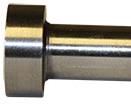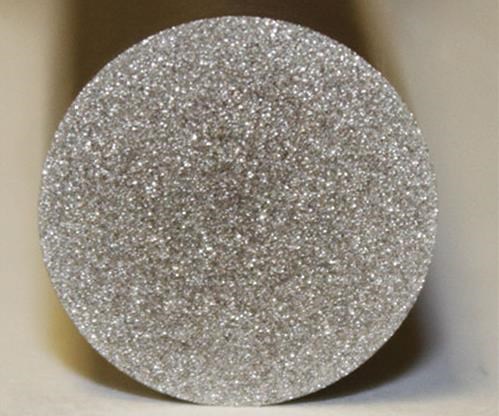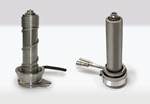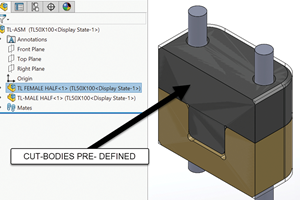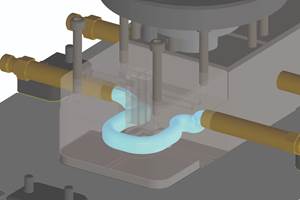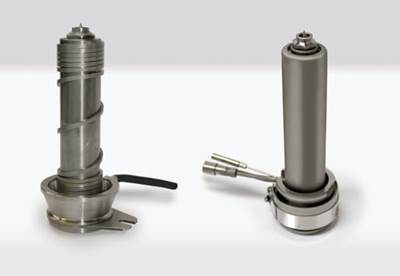For Better Mold Venting, Start with the Metal
Selecting the right material for specific mold components can help prevent a number of costly issues.
As part specifications and complexities continue to rise, proper mold venting is increasingly critical. Insufficient venting can lead to burning, shrinking and other costly issues (not to mention longer cycle times). Selecting the right material for certain mold components can go a long way toward preventing these problems.
For example, a porous sintered metal, such as one that is composed of 25 percent air by volume1, can vent gas without the need for a separate venting component. As a result, core pins and plugs made with this material help reduce mold size, cost and complexity. You can use this material to help your customers achieve better part cosmetics, while also saving time and money.
A porous metal eliminates trapped gas in the mold. It is heat-treated to 30 to 40 HRC with porosity around 20 to 30 percent by volume. A system of interconnected pores with an average diameter of 7 micron (0.0003 inch) or 20 micron (0.0008 inch) is dispersed throughout the material. This porosity is the key to the material’s effectiveness.
When used as a core pin material, the metal eliminates trapped gas problems that occur in inadequately vented areas within the mold. It is often difficult to provide adequate venting in these hard-to-mold areas. Traditional methods of venting, such as parting-line vents and vent plugs and pins, often do not provide sufficient surface area to accommodate the large volumes of gases that can be generated. This material provides a location-specific method of venting gas in a targeted area. Since it is 25 percent air by volume, 1/4 of the surface area becomes a vent. The larger the surface area of the piece installed, the greater the venting capacity.
Material Benefits
This method of venting delivers numerous benefits, including reducing injection pressure as well as substantially reducing scrap and reject rates. Utilizing a porous sintered metal for core pins and plugs also enhances part production in the following ways:
Prevents burning and shrinkage.
Burning is a condition caused by compressed gases trapped by the flow of molten resin in a cavity pocket. By using a porous metal, gases are permitted to evacuate through the steel to the outside atmosphere, thus eliminating the burning condition. Additionally, air bubbles trapped between the resin and mold steel surface can cause shrinkage or sink that shows as a ripple in the otherwise straight plastic surface. Using a porous metal on the trapped-air side of the cavity will eliminate shrink in most cases.
Prevents flow and knit lines.
Minimizing or eliminating flow and knit lines is an additional benefit of using this material. Knit lines occur at points where resin flows converge after molding around an obstruction or protrusion within the mold, usually away from the gate area. There are two primary reasons for this occurrence:
1. The failure of resin to sufficiently fuse due to the temperature drop it experiences after flowing over long distances.
2. The presence of residual air at the resin flow convergence point at the cavity obstruction, prohibiting the proper fusion of the flows.
The permeability of a porous metal prevents defects that arise from residual gases normally trapped inside the mold cavity. Also, using this material reduces back pressure and improves the flow rate, enabling the resin flows to merge while still hot.
Reduces cycle time.
Because of the reduction in back pressure within the mold, the plastic fills the cavity faster, thus allowing for a reduction in temperatures, which shortens cooling and cycle times.
Eliminates short shots.
A short shot is another condition caused by too low of an injection pressure or trapped gases in pocket areas of the cavity. This results in the part not being completely filled out. A porous metal reduces back pressure, therefore, less injection pressure is needed. And because it vents trapped gases, both causes of short shots are eliminated.
Enhances part appearance.
By using a porous metal in the mold, webbed, ribbed and other difficult-to-fill, thin-walled designs are greatly enhanced and cosmetically defined. Molding highly detailed, thin-walled and aesthetic parts is easily accomplished with the reduced back pressure and added venting of this material.
Reduces gloss.
When using a porous metal as a cavity in an injection mold, the air that would otherwise get trapped between the cavity and the resin and cause a gloss to show on the part is instead allowed to escape through the pores, thus leaving a dull matte finish. This often eliminates the need for costly secondary spray-painting operations.
Simplifies the tool.
When back pressures, injection pressures and cycle times are lowered, fewer drops are needed to ensure proper filling of the cavity. Lowering the number of drops needed simplifies the design while saving tool costs.
Aids in part ejection.
In many situations, an air poppet is needed to help break the vacuum from the core in a molded part. Inserting a porous metal into the core with an air blow setup helps break the vacuum seal and aids the ejector pins in doing their job.
Design Guidelines
While porous metal is ideal for core pins and plugs, there are some practical guidelines to consider when determining its suitability for various other applications.
Resin type.
Depending on the emissions or gas residue given off during the molding process, the molder will have to evaluate whether to use a 7- or 20-micron pore size. Resins such as ABS, polypropylene, soft-type PVC, polyethylene, acrylic, polyurethane and styrene work very well with a 7-micron (0.0003-inch) pore size.
For low-viscosity or talc-filled resins, it may be necessary to have an automated system reverse the airflow after each shot to purge the impurities from the pores. Rigid PVC resins, phenolics and natural rubber resins will work, but only until the corrosive gases close the pores. This can still be a feasible method if disposable inserts are used.
The 20-micron (0.0008-inch) pore size will vent about 25 percent more gas than the 7-micron pore size, so, where extreme venting is needed, a 20-micron pore size is recommended. The 20-micron grade was developed to be used with a milled finish. When milled properly, this process leaves a pore that is partially open (about 40 to 50 percent).
Rigid PVC, clear polycarbonate, liquid silicone and foaming urethanes all are questionable resins to use with this material and should be avoided.
Proper venting.
Experts recommend that at least 10 percent of the cavity area be made of a porous sintered metal to ensure proper venting. While this is not always possible, it is important to remember that the more square inches of venting that are used in the cavity area, the lower the back pressure will be in the cavity. However, if the distance that air has to travel through the material, and ultimately to the exhaust line, is excessive, then venting capacity will be compromised.
Thus, the shorter the distance through the metal to the exhaust line, the better. Due to the larger surface area, the insert will not require cleaning quite as often as a smaller piece. If a porous metal is used as a core or cavity half instead of as an insert, there may not be a need for parting line vents.
Cleaning and maintenance.
A porous metal is generally a low-maintenance material, but proactive cleaning is still needed occasionally. There are two times cleaning must be performed with this material. The first is when the tool shop has prepared the insert or cavity. The material is 25 percent air by volume, and the cutting fluids will displace the air, thus filling and clogging the pores. After the permeability has been restored, by either stoning or EDM of the venting surface, the steel should be placed in an oven at about 350°F for 2 to 3 hours. This will thin and remove most of the fluids in the pore structure. Once cooled to room temperature, the material should be placed in an ultrasonic cleaning unit built for flammable solvents that is filled with acetone.
Cleaning is also needed after the insert or cavity has been in operation and a film—a thin layer of mold release agent, resin residue, shop oil or any other contaminate—has partially or totally blocked the air flow. In addition to these cleaning methods, it may be necessary to use air pressure to back-flush the porous metal inserts with acetone in order to thoroughly clean them. However, waterlines should not be run through a porous material, since they are difficult to seal and will rust the material.
Additionally, polymers with flame retardants will require more frequent cleaning. This is where the reverse blow-back capability is ideal, as reverse air flow will happen with each cycle of the mold to assist in keeping the porous metal clean.
Summary
The unique properties of a porous sintered metal make it an ideal material to use in core pins and plugs. By preventing wasted or burned materials during a part’s production, moldmakers can help their customers achieve better part aesthetics, while also saving time and money. This material helps vent the unwanted gases that build up inside a mold and lead to imperfections. As a result, core pins and plugs made with a porous metal can help molders prevent burning and shrinkage as well as flow and knit lines, all while reducing cycle times and enhancing part appearance.
1 DME Company manufactures a line of core pins and plugs made of Porcerax II called Vortex.
Related Content
How to Supply Cooling to Additive Tooling
Additive tooling provides limitless options for cooling a mold’s difficult-to-cool areas.
Read MoreA 3D Printing Retrospective
A personal review of the evolution of 3D printing in moldmaking throughout the past 25 years.
Read MoreEjector Pin Selection Guide
A review of materials, treatments and coatings to help determine the proper pins for optimized plastic part ejection.
Read MoreRead Next
Standardizing Short- and Long-Run Production
New hot sprue bushing technology makes it possible to replicate the full hot runner system for low-volume production.
Read MoreHow to Use Continuing Education to Remain Competitive in Moldmaking
Continued training helps moldmakers make tooling decisions and properly use the latest cutting tool to efficiently machine high-quality molds.
Read MoreHow to Use Strategic Planning Tools, Data to Manage the Human Side of Business
Q&A with Marion Wells, MMT EAB member and founder of Human Asset Management.
Read More
